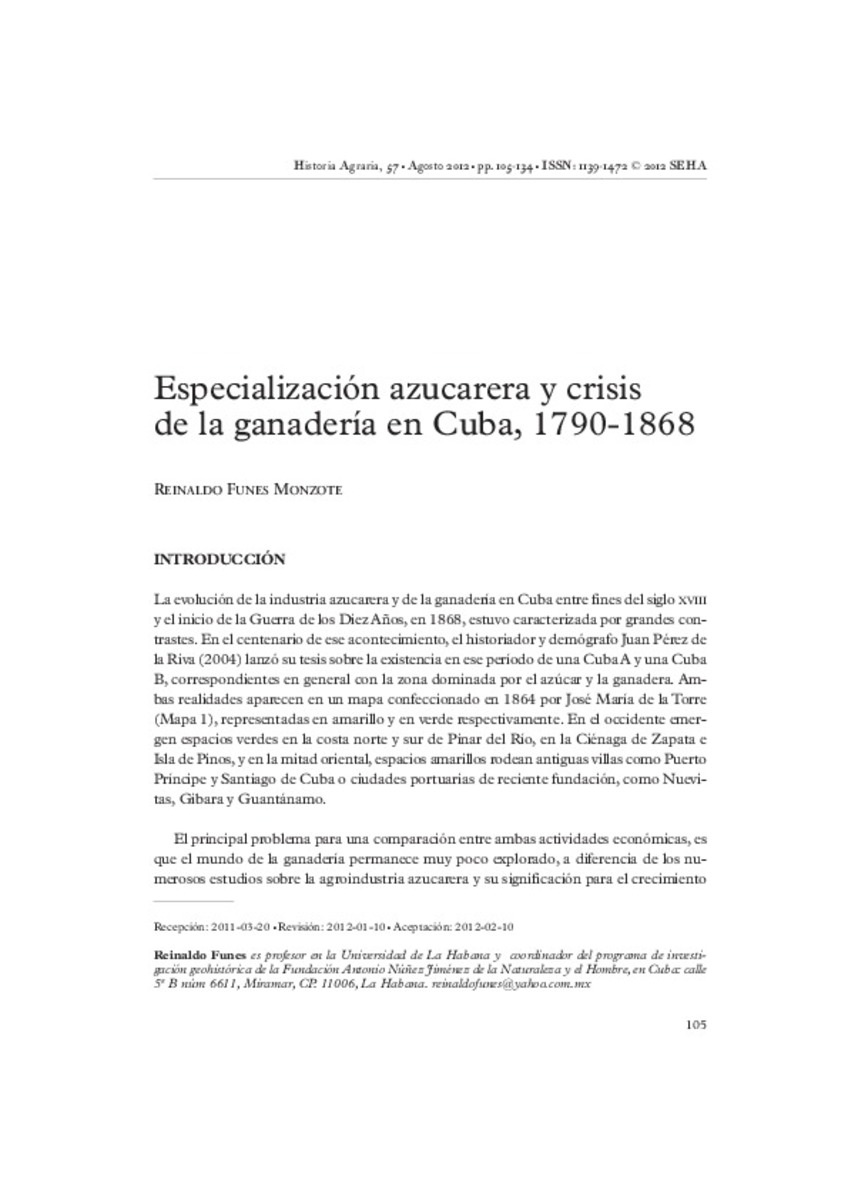Mostrar el registro sencillo del ítem
Especialización azucarera y crisis de la ganadería en Cuba, 1790-1868.
| dc.contributor.author | Funes, Reinaldo | |
| dc.date.accessioned | 2016-02-12T12:21:38Z | |
| dc.date.available | 2016-02-12T12:21:38Z | |
| dc.date.issued | 2012-08 | |
| dc.identifier.issn | 1139-1472 | |
| dc.identifier.uri | http://hdl.handle.net/10234/149766 | |
| dc.description.abstract | La gran especialización de Cuba en el azúcar en el siglo XIX, que convirtió a la colonia española en la principal productora y exportadora del mundo, ha hecho que la mayoría de los estudios sobre la historia agraria de ese período se centren en el crecimiento espectacular de esta agroindustria. Por el contrario, la ganadería permanece como uno de los temas menos estudiados. En este trabajo se ofrecen elementos sobre la diferente evolución de ambas actividades agropecuarias, contrastando el auge de la primera, basada en el sistema de plantaciones esclavistas y la decadencia de la segunda, orientada más al mercado interno. Se atiende en particular a los efectos de la política comercial implementada por la metrópoli y del inicio temprano de la sustitución de fuerza animal por la mecanización azucarera y los ferrocarriles, lo que profundizó la crisis de la ganadería en la mitad centro oriental de la Isla. | ca_CA |
| dc.description.abstract | Cuba's specialisation in sugar during the nineteenth century converted the Spanish colony into the world's principal producer and exporter of this commodity. This has meant that the majority of the research conducted into the country's agrarian history during this period has inevitably been centred on the remarkable story of sugar. On the other hand, the rearing of livestock is a sector that has inspired little academic interest. In this paper different aspects of the evolution of both activities are offered, contrasting the boom in sugar production, based on large, slave‐plantations, with the decline of the livestock industry, which was more orientated to the internal market. Particular focus has been given to the effects of the commercial policies implemented by the metropolis, and the early substitution of animal power for mechanisation and rail transport. Both of these factors deepened the crisis in the livestock sector in the east‐central part of the island. | ca_CA |
| dc.format.extent | 30 p. | ca_CA |
| dc.format.mimetype | application/pdf | ca_CA |
| dc.language.iso | spa | ca_CA |
| dc.publisher | Sociedad Española de Historia Agraria (SEHA) | ca_CA |
| dc.relation.isPartOf | Historia agraria: Revista de agricultura e historia rural, nº 57, pp. 105-134 | ca_CA |
| dc.rights | © 2012 SEHA | ca_CA |
| dc.rights.uri | http://rightsstatements.org/vocab/InC/1.0/ | * |
| dc.subject | Cuba | ca_CA |
| dc.subject | industria azucarera | ca_CA |
| dc.subject | ganadería | ca_CA |
| dc.subject | política comercial | ca_CA |
| dc.subject | bueyes | ca_CA |
| dc.subject | sugar industry | ca_CA |
| dc.subject | stockbreeding | ca_CA |
| dc.subject | commercial policy | ca_CA |
| dc.subject | oxen | ca_CA |
| dc.title | Especialización azucarera y crisis de la ganadería en Cuba, 1790-1868. | ca_CA |
| dc.type | info:eu-repo/semantics/article | ca_CA |
| dc.subject.jel | N5 | ca_CA |
| dc.subject.jel | N7 | ca_CA |
| dc.subject.jel | O3 | ca_CA |
| dc.subject.jel | Q1 | ca_CA |
| dc.rights.accessRights | info:eu-repo/semantics/openAccess | ca_CA |
| dc.relation.publisherVersion | http://historiaagraria.com/info_articulo.php?id=611 | ca_CA |







